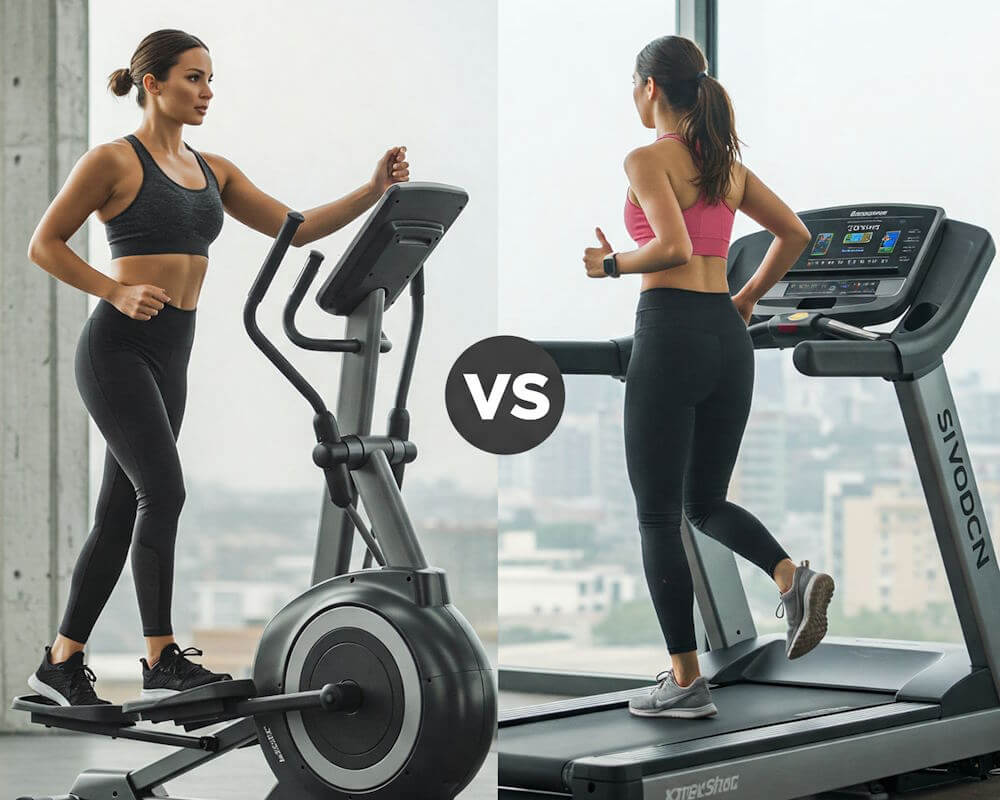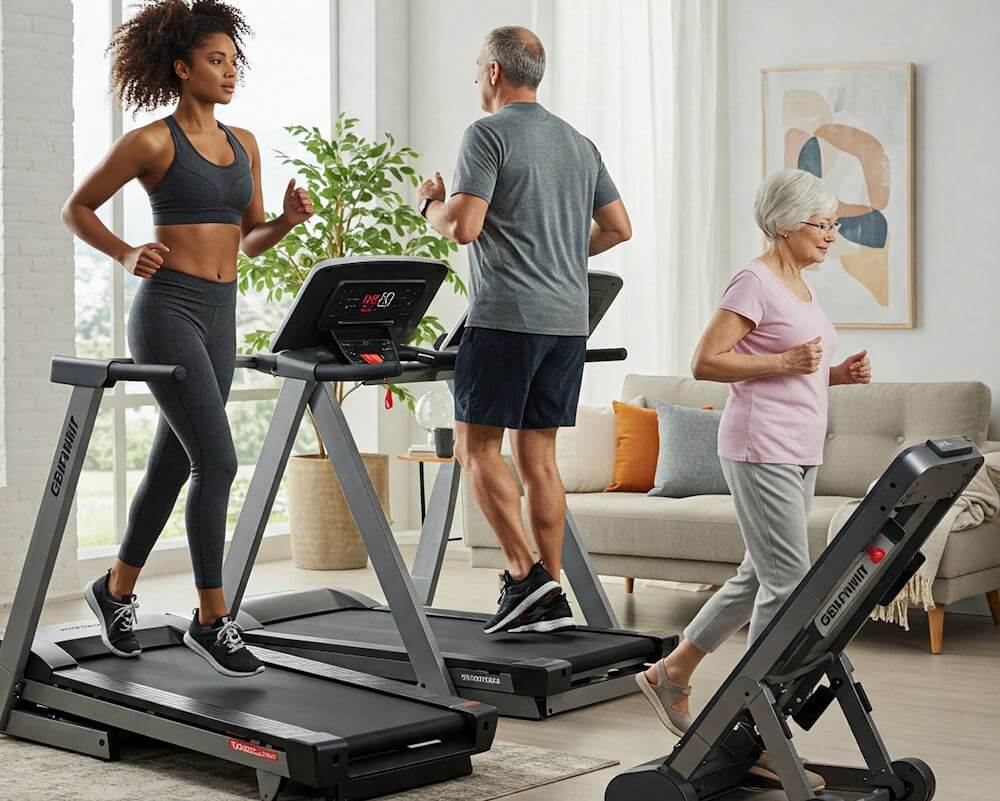Cardiovascular exercise plays a crucial role in maintaining overall health and fitness. Engaging in regular cardio workouts supports heart health, enhances lung capacity, and aids in weight management. Furthermore, cardiovascular activities can significantly improve mental well-being by reducing stress and promoting better sleep patterns. Given these benefits, many individuals are inclined to incorporate cardiovascular equipment into their home or gym routines.
Among the array of options available, elliptical machines and treadmills stand out as two of the most popular choices for cardio workouts. Each offers unique advantages that cater to different fitness levels and preferences. The elliptical machine is designed to provide a low-impact workout while mimicking the motion of running, making it an excellent option for individuals concerned about joint strain. This equipment allows for both upper and lower body engagement, ensuring a comprehensive workout experience.
Conversely, treadmills serve as a staple in cardiovascular exercise, offering users a platform to walk, jog, or run indoors regardless of weather conditions. The versatility of treadmills allows for customized workouts, including varying speed and incline settings, thereby accommodating diverse fitness goals. For those looking to improve their running or walking endurance, treadmills provide the necessary training simulation.
As we delve deeper into the comparison between elliptical machines and treadmills, it becomes essential to evaluate the specific features, benefits, and potential drawbacks of each type. Understanding the unique attributes of these cardiovascular machines will assist individuals in making informed decisions tailored to their personal fitness needs and preferences. This examination aims to clarify which piece of equipment can yield the best results for the user’s lifestyle and goals.
Understanding the Elliptical
The elliptical machine is a popular fitness equipment designed to simulate walking, running, or stair climbing while minimizing the impact on your joints. Unlike a treadmill, which subjects your body to repetitive pounding, an elliptical facilitates a smoother, more controlled motion. This low-impact aspect makes it particularly appealing for individuals recovering from injuries or those who may be prone to joint discomfort.
One of the defining features of an elliptical is its ability to provide a full-body workout. The machine typically includes moving handlebars that allow users to engage their upper body while simultaneously working their lower body. This dual engagement can enhance overall muscle tone and increase the calorie burn potential of each session. As you push and pull the handlebars, you can activate key muscle groups in your arms, shoulders, and chest, complementing the leg workout achieved through the pedaling action.
The versatility of workout options presented by an elliptical is another significant advantage. Many models come equipped with adjustable resistance levels, incline settings, and varied pre-programmed workouts, which cater to different fitness levels and goals. Whether you’re in the mood for a gentle recovery session or an intense interval workout, the elliptical can accommodate your needs.
Additionally, recent studies suggest that using an elliptical can result in higher calorie expenditure compared to steady-state cardio on a treadmill, especially when high-intensity intervals are incorporated. This makes the elliptical an excellent choice for individuals looking to maximize calorie burn while also prioritizing joint health. Overall, the benefits and features of an elliptical make it a worthy contender for those seeking an effective, low-impact workout solution.
Understanding the Treadmill
The treadmill is a versatile piece of exercise equipment that simulates running or walking in a controlled indoor environment. It operates through a conveyor belt system, allowing users to walk or run at various speeds while maintaining stability. Treadmills often come with digital displays that provide essential information such as elapsed time, distance covered, speed, and calories burned.
One of the primary features of most treadmills is the ability to adjust speed settings. This versatility caters to different fitness levels, enabling users to engage in a leisurely walk or an intense sprint based on their workout goals. Along with speed adjustments, many treadmills also offer incline settings. By changing the incline, users can simulate uphill running or walking, which increases the intensity of the workout and engages more muscle groups. This feature not only adds variety to workouts but also enhances overall effectiveness.
The treadmill is well-regarded for its cardiovascular benefits. Regular use can lead to improved heart and lung health, as it elevates the heart rate and promotes better circulation. Whether someone is recovering from an injury or training for a marathon, a treadmill provides an adaptable platform for various workout intensities. Additionally, the consistent surface of a treadmill reduces the risk of injury commonly associated with uneven outdoor terrains.
Furthermore, many modern treadmills are equipped with additional features such as built-in workouts, heart rate monitors, and connectivity options for music or fitness tracking applications. These features promote an engaging exercise experience, potentially increasing adherence to a fitness routine. In summary, the treadmill serves as a comprehensive tool for enhancing cardiovascular fitness and accommodating diverse workout preferences, making it a popular choice for home and gym settings alike.
Comparing Caloric Burn and Intensity
When evaluating the calorie-burning potential and intensity levels between elliptical machines and treadmills, several factors come into play, including user weight, workout duration, and exercise intensity. Both options can serve as effective cardiovascular workouts, but the specifics can vary greatly depending on the individual’s fitness goals and preferences.
Elliptical machines generally allow users to engage in a low-impact workout, making them suitable for those who may have joint concerns or are recovering from injuries. The calorie burn on an elliptical is influenced by the resistance level set on the machine and the user’s weight. Studies suggest that an average person can burn approximately 270 to 400 calories in a 30-minute session on the elliptical, depending on these variables. Furthermore, the incline feature available on many ellipticals can also amplify calorie expenditure, thereby increasing workout intensity.
Treadmills, on the other hand, offer a higher versatility in terms of workout intensity. Users can manually alter speed, incline, and even choose preset interval training programs. This allows for a customized workout experience that often encourages greater cardiovascular exertion. On average, a person may burn anywhere from 300 to 600 calories during a 30-minute high-intensity run or a brisk walking session on a treadmill, again influenced significantly by individual weight and workout conditions. The workout intensity on a treadmill usually provides a demanding cardiovascular challenge that appeals to those looking to enhance their aerobic fitness.
In essence, both machines present effective means to achieve caloric burn, albeit under different conditions. Users need to consider their fitness objectives, any physical limitations, and personal preferences when deciding which machine may better complement their workout regimen.
Impact on Joints and Injury Risks
When it comes to choosing between an elliptical machine and a treadmill, understanding their impact on joint health is crucial, particularly for individuals with pre-existing conditions or chronic injuries such as arthritis. Both forms of exercise offer unique benefits and drawbacks that can significantly influence one’s fitness experience.
Ellipticals stand out for their low-impact nature. The design of these machines allows users to maintain a fluid and continuous motion that mimics running without the harsh shock that comes from pounding on a treadmill surface. This characteristic makes ellipticals a favorable choice for those concerned about joint stress. The pedals of an elliptical machine reduce the impact on knees, hips, and ankles, distributing weight evenly while promoting a natural movement pattern. Consequently, this results in less strain on the joints, which can be particularly beneficial for individuals recovering from injury or those who experience joint pain during high-impact activities.
In contrast, while running on a treadmill can offer an excellent cardiovascular workout, it often subjects the joints to repetitive high-impact forces. The foot strikes generated during running can increase stress on the knees and other weight-bearing joints. This may exacerbate existing joint problems or lead to new injuries, particularly for individuals who are overweight, lack proper running form, or do not wear appropriate footwear. Additionally, the lack of cushioning in some treadmill models can further increase the risks associated with high-impact activities.
Overall, individuals with joint concerns may find ellipticals more suitable, while treadmill users should take precautions to mitigate joint stress, such as ensuring proper footwear and incorporating strength training to support joint stability. Understanding these differences is essential to making an informed decision that prioritizes joint health and minimizes the risk of injury.
User Experience and Convenience
When evaluating the user experience of elliptical machines and treadmills, several factors come into play including comfort, ease of use, and the adaptability of workouts. Both types of equipment are designed to cater to different fitness preferences and levels, influencing how users engage with them during their exercise routines.
Elliptical machines provide a low-impact workout that is gentle on the joints, making it an ideal choice for individuals who may experience discomfort on harder surfaces. Users can maintain a smooth and fluid motion, which contributes to a more enjoyable experience over longer sessions. Additionally, many elliptical models come with adjustable resistance settings and incline features, allowing for a customizable workout that can accommodate various fitness goals.
Treadmills, on the other hand, present a different user experience. They typically allow users to replicate outdoor running or walking, offering a more natural stride. However, the impact of running can be taxing on the knees and hips, particularly for those who are new to exercise or have existing joint concerns. Modern treadmills often include features such as preset workout programs and incline options to enhance the adaptability of workouts during each session.
The convenience factor is also significant when it comes to the overall user experience. Many individuals prefer to engage in activities such as watching TV or reading while exercising. Ellipticals often come equipped with built-in displays and areas for placing devices, making it easier for users to multitask. Treadmills may offer similar features, but the intensity of running can make it more challenging to focus on secondary activities. Ultimately, choosing between an elliptical and a treadmill may depend on a user’s preference for comfort and the type of exercise environment they find most conducive to enjoyment.
Cost and Space Considerations
When deciding between an elliptical and a treadmill, potential buyers must carefully evaluate the costs and space requirements associated with each option. Generally, the purchase price of these machines can vary significantly, depending on brand, features, and build quality. Treadmills are often available at a lower entry-level price point, starting around $500 for basic models. However, high-end treadmills can reach $3,000 or more, especially those equipped with advanced technology or heavier construction.
In contrast, ellipticals often have a higher starting cost, with prices beginning around $800 and going up to $4,000 for commercial-grade machines. The price disparity reflects differing construction and user experience. Ellipticals tend to offer a low-impact workout that may appeal to those with joint issues, while treadmills provide a more straightforward running and walking simulation.
When it comes to space requirements, treadmills generally require a larger footprint than elliptical machines, especially during operation. A standard treadmill can occupy around 30 square feet, while an elliptical typically requires about 20 square feet in total. For those with limited space, many elliptical models are designed to be more compact and may feature a foldable design for convenient storage. Additionally, it is crucial to consider ceiling height when installing either machine, as users need adequate headroom to exercise comfortably and safely.
For budget-conscious consumers, both treadmills and ellipticals offer diverse price ranges, making it feasible to find an option that fits within a specific financial plan. Moreover, exploring second-hand equipment is another viable route, often yielding significant savings. Ultimately, evaluating both cost and space is vital for determining the most suitable exercise machine for your home gym setup.
Personal Fitness Goals and Preferences
When considering whether an elliptical or treadmill is better suited to your fitness needs, it is crucial to evaluate your personal fitness goals and preferences. Different individuals may prioritize various outcomes from their exercise routines, such as weight loss, endurance training, or rehabilitation. Understanding your objectives can greatly influence your decision and help you select the most appropriate equipment for your workouts.
If weight loss is your primary goal, both the elliptical and treadmill can provide effective calorie-burning workouts. The treadmill, with its varied intensity levels, allows you to engage in high-intensity interval training (HIIT), which is known for its efficiency in fat loss. On the other hand, the elliptical offers a low-impact alternative that reduces stress on the joints while still providing substantial cardiovascular benefits. This makes it a suitable option for those who might have concerns about injury or are recovering from previous injuries.
For individuals aiming to improve their endurance, incorporating both machines could be beneficial. The treadmill builds strength and stamina through varied terrain options, replicating outdoor running conditions. Meanwhile, the elliptical can enhance muscle endurance through its combined use of both upper and lower body movements, engaging more muscle groups during workouts. This is particularly advantageous for those looking to improve overall fitness or prepare for specific athletic activities.
Another aspect to consider is personal comfort and enjoyment. Some individuals prefer the natural gait of walking or running on a treadmill, while others find the smooth, fluid motion of the elliptical more enjoyable. Ultimately, the best choice hinges on a comprehensive understanding of your fitness aspirations and what activities you find motivating. Reflecting on these parameters ensures that the equipment you choose aligns with your personal journey toward achieving optimal health and fitness.
Conclusion: Making the Right Choice for You
Choosing between an elliptical and a treadmill largely depends on individual preferences and fitness objectives. Each machine has its own set of advantages that cater to different workout styles and goals. The elliptical trainer is often favored for its low-impact nature, making it an excellent choice for individuals recovering from injuries or those seeking a gentler workout experience. It engages multiple muscle groups simultaneously, offering a comprehensive cardiovascular session without the harsh impact on joints that running can sometimes cause.
On the other hand, treadmills are widely regarded for their versatility and proximity to natural walking or running experiences. They provide an excellent platform for cardiovascular training that can boost stamina and facilitate weight loss. A treadmill’s ability to simulate outdoor conditions allows users to customize their workouts significantly, including incline adjustments and varied speed settings, catering to those targeting specific fitness goals. For avid runners or those looking to improve their speed and agility, a treadmill may offer targeted benefits that are hard to replicate on an elliptical.
When deciding between these two machines, one should consider factors such as workout comfort, fitness goals, and any pre-existing injuries. It is essential to evaluate the level of versatility and diversity offered by each option, as well as personal enjoyment in their use. After completing a thorough analysis of both machines, individuals will be better equipped to select the one that aligns with their fitness aspirations. Ultimately, the best choice is one that resonates with personal preferences and motivates consistent exercise, thereby leading to a healthier lifestyle.



